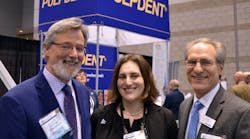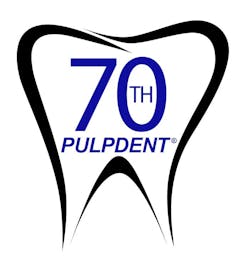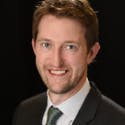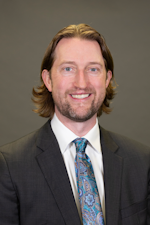It began with a dancing dentist: How Pulpdent quietly became one of dentistry's leading research, development, and manufacturing companies
In this interview, Pulpdent's Fred Berk discusses the company's 70-year journey from small trading outfit to R&D powerhouse.
Berk recounts Pulpdent's history, starting with his father, Dr. Harold Berk, who cofounded the company. Dr. Berk was a "wet-finger dentist" who developed and patented the first premixed calcium hydroxide-aqueous methylcellulose pulpal dressing. He also danced a little.
Above: Pulpdent's Larry Clark, Leah Berk, and Fred Berk.
Leah is one of the third-generation Berks now helping lead the family-owned company.
Editor's note: This article is part one of a two-part feature. In part two, Fred Berk discusses the development of Activa (tr. "ACTIVA"), a bioactive product that stands as Pulpdent's latest innovation in the field of dental materials. Part two will be published in April.
When Harold Berk, DDS, cofounded Pulpdent in 1947, he and his partner started what would become a multigenerational family business and leader in the dental materials industry. To understand how the Massachusetts-based company evolved from a small trading outfit to a forerunner in bioactive dental materials, I spoke to Pulpdent Vice President Fred Berk, one of Dr. Harold Berk's three sons who now lead the company.
Take us back to your early days with the company. How were you brought into the business, and what was Pulpdent like back then?
Our father, Dr. Harold Berk, developed and patented the first premixed calcium hydroxide-aqueous methylcellulose pulpal dressing. Dad was a researcher and wet-finger dentist—he was not a businessman. Although LD Caulk offered to take the product, Dad was adventurous, and instead he and Ben Rower founded the Rower Dental Manufacturing Co. (now Pulpdent) in 1947 to promote Pulpdent Paste. It was not long before they hired a manager and were essentially absentee owners.
[Rower Dental Manufacturing] was really a very small trading company with a few proprietary items, but mostly they were importing. In junior high and high school, my brothers and I did packaging for the company and learned the value of work and saving money. When we bought out Ben and took over the company in 1975, there were five employees, and two of them were part-time.
Looking back, what have been some of the biggest business challenges you've had to overcome in maintaining the growth of the company?
We had to decide what we wanted to do, and we decided to go into manufacturing. We had little experience, and we really started from scratch. The company had outsourced the few items it manufactured, so we set up a small lab to make the powders, pastes, and gels, and we built a machine shop to make amalgam carriers, which was one of our staple products. We bought this big old Cleveland screw machine from World War I, took it apart, refurbished it, painted it red, black, and silver, and we were in business. An elderly gentleman, Ed Olsen, taught us how to run it. I can still see him there with his oil rag, calipers, and blue smock over his white shirt and bow tie.
This is an industry of proprietary formulations and trade secrets, and there is no textbook for making dental materials. Over the years, we have invested heavily in research, and our manufacturing has become very sophisticated. Developing a robust quality management system and regulatory affairs department has been one of our great strengths and given us a competitive advantage. This has also been important to support our research and development endeavors.
What are some of your favorite memories of your father, and what was he like as a person?
Dad was a very talented man, and he was very social and would talk to anyone who would listen, usually about dentistry or growing up in Dubuque, Iowa. His sister had a dance school and performing troupe, and Dad was her leading man. He never went to work at Pulpdent, and he never ran the company. He loved nothing more than practicing dentistry, and his favorite day was the one he spent each week at Tufts, where he was on the faculty of the dental school for 59 years. What Dad would want you to know is that of all the dancers, he was the best dentist, and of all the dentists, he was the best martini maker.
Over the past 70 years, Pulpdent has grown from a small family-owned business to an innovator in the dental industry. What were the major milestones that defined the growth of the company?
Pulpdent is not only a family-owned business, it is a business of families. We have five Berks working here now, but there are other families with as many or more family members at the company.
From 1975 to 1985 we became manufacturers. There was an enormous learning curve pertaining to chemical production and machine engineering, and the challenge never ends.
In the next decade we got involved in organic chemistry with the production of dental resins such as sealants, cements, core build-up materials, and orthodontic adhesives. It was also during this time that we produced etching gels, bonding agents under license from the American Dental Association Health Foundation, and other accessory products for adhesive dentistry.
From 1995 to 2005 we made a huge leap in our scientific research by developing the first hydrophilic dental resin, which we called Embrace WetBond. Released in 2002, Embrace was an amazing innovation that started us on the path to the leadership position in bioactive materials we enjoy today.
In 2007, we synthesized and patented a new rubberized-urethane molecule that adds toughness and fracture resistance to a hard composite material. This innovation is an important contribution to the durability of dental materials, and the first product with this technology was our provisional material, Tuff-Temp. Over the past decade, we have beefed up our research staff and our commitment to what we believe is a better approach to oral health care. This model focuses on prevention and materials that play a dynamic role in the mouth and provide direct benefits to teeth and oral health. This new direction is a departure from traditional materials that adhere to the old philosophy of being passive and doing no harm—a totally negative approach. Our introduction of Activa Bioactive [tr. "ACTIVA BioACTIVE"] materials in 2013 was a watershed in esthetic dental restorative materials, and the market acceptance has been quite amazing.
In your mind, who are some of the important people who have built Pulpdent into what it is today?
We have an incredibly loyal staff and almost no turnover. My brothers, Ken and Don, are the driving force for research, product development, and manufacturing. They dream, and then it happens. Larry Clark has been instrumental in delivering our message to the world and educating the dental community worldwide. Marjorie Cote and her team have developed a quality management system that impresses our auditors. Marcy Buckler has energized our sales team. Gale and Eric Boyd have managed our administrative and factory production for 25 years. Jay R. Clover came to us out of high school in 1979 and helps manage our factory and production staff. There are so many more, including the dental dealers, sales reps, and dentists who have supported us throughout the years.
Running a family business can be fun, but it can also test one's patience. Describe the dynamic between you and your brothers. What do each of you bring to the company? Also, talk about what it's been like bringing the next generation of Berks into the business.
We have different skills, and while we push each other along, we try not to step on each other’s toes. We allow each other the freedom to do what we do best, and we compensate for the rest. We have learned that when it comes to science and manufacturing, deadlines don’t work. There is no telling how long it will take to get things right.
The next generation has yet another set of skills. We grew up with slide rules and three TV stations. They grew up with computers and social media. We see the opportunity to build a new management team around the next generation.
Where do you see your strongest competition coming from in the coming years? Without giving anything away, how are you preparing for the future of the dentistry as it continues to evolve?
There is always competition. We stay ahead of it by investing in research and new technologies. Most dental companies market me-too products purchased from another vendor. Large companies with in-house research capabilities are often slow to move on new technologies. The investment is great, management may not understand the technology, and the return—if any—is far down the road. Especially for publicly held companies, research investments do not show up favorably in the quarterly earnings. A privately held company like Pulpdent can make decisions quickly and invest in research without worrying about share price.
We have already developed, tested, and received FDA premarket approval for the second generation of esthetic bioactive restorative materials. Watch for more Activa products in 2018.
Pulpdent is known for giving back to the community. Why do you think this value is so strong in your family and the company?
After graduating from Northwestern Dental School, Dad interned at the Forsyth Dental Clinic in Boston and soon became the head of the clinic. Forsyth was involved in public health and served a diverse population. We grew up knowing that helping people live in comfort and smile with confidence was the right thing to do. It was natural for us to support organizations that deliver dental care to underserved populations. We get pictures from rural communities around the world where we have donated products and made a difference in people’s lives, and they always put a smile on our faces.
Is there anything else you'd like readers to know?
Medical devices are a serious business, and by deciding to pursue research, product development, and manufacturing, we did not choose the easy road. But Pulpdent has been—and still is—our sandbox. It has allowed us to be innovative and creative while demanding tremendous discipline. We have been free to follow our dreams without anyone telling us they are not possible, or would not be funded, and this has led to discoveries that improve dental care and point to the future of dentistry. It is an exciting time at Pulpdent.
Zachary Kulsrud is senior editor of PennWell's dental group. He serves as chief editor of Apex360 and managing editor of Dental Economics, and oversees the editorial team of DentistryIQ and Perio-Implant Advisory. His background includes work in advertising and broadcast production.
MORE FROM THIS AUTHOR:
15,000 patients a day: Exclusive interview with Bob Fontana, CEO of Aspen Dental Management Inc.
Dental school disruption 101
The making of master craftsmen: Inside the groundbreaking Hu-Friedy apprenticeship program
Editor's note: This article first appeared in the Apex360 e-newsletter. Apex360 is a DentistryIQ partner publication for dental practitioners and members of the dental industry. Its goal is to provide timely dental information and present it in meaningful context, empowering those in the dental space to make better business decisions. Subscribe to the Apex360 e-newsletter here.











